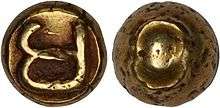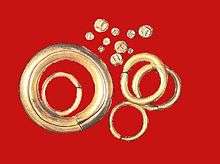Piloncitos
Piloncitos (also known as Bulawan) are tiny engraved gold coins or weights found in the Philippines from the Archaic period (pre-Hispanic era).

| Numismatics |
|---|
.png) |
| Currency |
| Circulating currencies |
|
| Local currencies |
|
Fictional currencies Proposed currencies |
| History |
| Historical currencies |
| Byzantine |
| Medieval currencies |
| Production |
| Exonumia |
| Notaphily |
| Scripophily |
|
|
Trade among the early Filipinos and with traders from neighboring islands was conducted through Barter. The inconvenience of barter later led to the use of some objects as a medium of exchange. Gold, which was plentiful in many parts of the islands, invariably found its way into these objects that included the Piloncitos, small bead-like gold bits considered by the local numismatists as the earliest coin of ancient Filipinos, and gold barter rings. The word is derived from Spanish (same spelling), meaning "little weights."
Piloncitos is presumably an offshoot of the silver and may have evolved into the bullet or Pod duang coinage of Sukhothai in Thailand.[1]
Historical usage

Since ancient times, gold has been one of the main products of the islands. Both ancient and modern goldsmiths exude exquisiteness in their craftsmanship for trade, personal vanity and prestige.[2]
Piloncitos are the earliest form of precious metal based currency of Tondo, Namayan and Rajahnate of Butuan in present-day Philippines. It is likely made of pure gold with a weight ranging between 0.5 grams to more or less than 3 grams. Piloncitos are tiny engraved bead-like gold bits unearthed in the Philippines. They are the first recognized coinage in the Philippines circulated between the 9th and 12th centuries. They emerged when increasing trade made barter inconvenient.
Descriptions
Piloncitos are so small—some are of the size of a corn kernel—and weigh from 0.09 to 2.65 grams of fine gold. Large Piloncitos weighing 2.65 grams approximate the weight of one mass. Piloncitos have been excavated from Mandaluyong, Bataan, the banks of the Pasig River, Batangas, Marinduque, Samar, Leyte and some areas in Mindanao. They have been found in large numbers in Indonesian archeological sites leading to questions of origin. That gold was mined and worked in the Philippines is evidenced by many Spanish accounts, like one in 1586 that stated:
“The people of this island (Luzon) are very skillful in their handling of gold. They weigh it with the greatest skill and delicacy that have ever been seen. The first thing they teach their children is the knowledge of gold and the weights with which they weigh it, for there is no other money among them.”[3]
Other currencies or coinages used by early Filipinos

The early Filipinos traded Piloncitos also along with Gold rings, which is gold ring-like ingots. These barter rings are bigger than doughnuts in size and are made of nearly pure gold.[4]
They are also very similar to the first coins invented in the Kingdom of Lydia in present-day Turkey. Barter rings were circulated in the Philippines up to the 16th century.
Similarities in neighboring countries
Piloncitos is not exclusively found in the Philippines as most collectors and local historians state. Similar type of gold can be found in some regions of Indonesia which they call massa.[5]
Origins
In an era before coined money was widely used, Indo-Pacific beads were made first at a site called Arikamedu in South India ca. 200 BC. The manufacture then moved in sequence to Ceylon, South Thailand, Java and finally Malaya. By about 1200–1300 AD the larger Majapahit beads, excavated today in the interior of Java, had supplanted it. Since these factory sites have been dated, archaeologists now use the beads to date sites, though whether beads rose to the level of metals, salt, cloth, and cowries as "standard" trade goods is uncertain.[6]
The first indigenous metallic coinage in the region, ca. 750–850 AD, comes from the Javanese kingdom of Sailendra (Chinese: Ho-ling). These roughly dome-shaped silver of irregular weight bore stamps of a flowing vase, and the sandalwood flower (quatefoil). By 850 AD weights had been standardized at 20 rattis to a Massa of about 2.4 grams. Silver and gold coins of Massa and fractional denominations were issued until about 1300 AD, with changes in shape and quality of inscription marking periods of issue. The gold Piloncitos of the Philippines are a late offshoot of the gold coinage, while the bean-like silver "namo" series, of the Malay isthmus was presumably an offshoot of the silver and may have evolved into the bullet (Pod-Duang) coinage of Sukhothai in Thailand.[7]
See also
- Early Indonesian coins
- Philippine piso
- Philippine real
- List of historical currencies
- History of Philippine money
- Pod-duang
References
- http://coin.filipinonumismatist.com/2011/06/piloncitos-treasure-of-philippine.html
- "Archived copy". Archived from the original on 2012-12-15. Retrieved 2017-03-23.CS1 maint: archived copy as title (link)
- http://opinion.inquirer.net/10991/%E2%80%98piloncitos%E2%80%99-and-the-%E2%80%98philippine-golden-age%E2%80%99
- "Archived copy". Archived from the original on 2012-12-15. Retrieved 2017-03-23.CS1 maint: archived copy as title (link)
- http://coin.filipinonumismatist.com/2011/06/piloncitos-treasure-of-philippine.html
- http://coin.filipinonumismatist.com/2011/06/piloncitos-treasure-of-philippine.html
- http://coin.filipinonumismatist.com/2011/06/piloncitos-treasure-of-philippine.html
| Preceded by No modern currencies (Barter or Shells) |
Philippine currency c.10th -16th century |
Succeeded by Philippine real |